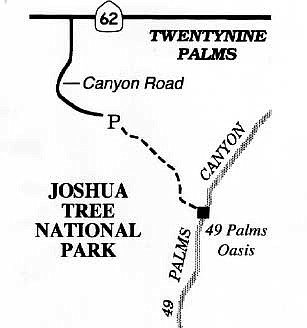 Facebook
Facebook
 X
X
 Instagram
Instagram
 TikTok
TikTok
 Youtube
Youtube
Native California fan palms (Washingtonia filifera), familiar to Anza-Borrego and Baja visitors, can be found as well in scattered locations amid the rocky defiles of Joshua Tree National Park, which lies some 100 miles north of the border. The Mojave Desert town of Twentynine Palms was named after Twentynine Palms Oasis (a.k.a. the Oasis of Mara), and today that grove of native palms is occupied by the national park's Oasis Visitors' Center. Just a bit farther afield from Twentynine Palms, you may hike a 1.5-mile trail to Fortynine Palms Oasis, where more than 49 palms -- massive veterans plus young upstarts -- huddle in a remote, rocky canyon bottom.

To find the way to Fortynine Palms trailhead, locate the obscure lane called Canyon Road, two miles east along Highway 62 from the entrance to Indian Cove, or four miles west along Highway 62 from "downtown" Twentynine Palms. Turn south on Canyon Road and drive straight to the trailhead parking lot. Then, on foot, walk uphill on a rough trail over crumbling rock and past sparse vegetation. Plant life is resurrected annually during the springtime bloom, which typically peaks in late March or early April. Despite this season's paucity of rain, you will likely see some barrel, hedgehog, and beavertail cacti in bloom, providing highlights of yellow and magenta. Mecca asters, with light-blue petals and yellow centers, plus daisy-like brittlebush plants, provide additional splashes of color.
The trail takes you up and along a ridge, then down steeply into the crease of Fortynine Palms Canyon, where a number of palms with fire-blackened trunks and abbreviated skirts of dead fronds stand statuesquely against the blue sky. Some of the palms cluster amid jumbled boulders and bushy, spiky vegetation. A few sycamores struggle upward into the sky, their roots drinking in water at the surface or not far underground. A few of the boulders are large and reasonably flat and can be used for lounging, socializing, sunbathing, or simply lying still in meditation. You can gaze outward to the northeast, where a little slice of the Mojave Desert floor is visible, or close your eyes and contemplate the dry breeze rattling the even drier tips of the palm fronds overhead.

Native California fan palms (Washingtonia filifera), familiar to Anza-Borrego and Baja visitors, can be found as well in scattered locations amid the rocky defiles of Joshua Tree National Park, which lies some 100 miles north of the border. The Mojave Desert town of Twentynine Palms was named after Twentynine Palms Oasis (a.k.a. the Oasis of Mara), and today that grove of native palms is occupied by the national park's Oasis Visitors' Center. Just a bit farther afield from Twentynine Palms, you may hike a 1.5-mile trail to Fortynine Palms Oasis, where more than 49 palms -- massive veterans plus young upstarts -- huddle in a remote, rocky canyon bottom.

To find the way to Fortynine Palms trailhead, locate the obscure lane called Canyon Road, two miles east along Highway 62 from the entrance to Indian Cove, or four miles west along Highway 62 from "downtown" Twentynine Palms. Turn south on Canyon Road and drive straight to the trailhead parking lot. Then, on foot, walk uphill on a rough trail over crumbling rock and past sparse vegetation. Plant life is resurrected annually during the springtime bloom, which typically peaks in late March or early April. Despite this season's paucity of rain, you will likely see some barrel, hedgehog, and beavertail cacti in bloom, providing highlights of yellow and magenta. Mecca asters, with light-blue petals and yellow centers, plus daisy-like brittlebush plants, provide additional splashes of color.
The trail takes you up and along a ridge, then down steeply into the crease of Fortynine Palms Canyon, where a number of palms with fire-blackened trunks and abbreviated skirts of dead fronds stand statuesquely against the blue sky. Some of the palms cluster amid jumbled boulders and bushy, spiky vegetation. A few sycamores struggle upward into the sky, their roots drinking in water at the surface or not far underground. A few of the boulders are large and reasonably flat and can be used for lounging, socializing, sunbathing, or simply lying still in meditation. You can gaze outward to the northeast, where a little slice of the Mojave Desert floor is visible, or close your eyes and contemplate the dry breeze rattling the even drier tips of the palm fronds overhead.
Comments